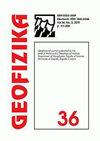Influences of outdoor meteorological conditions on indoor wintertime short-term PM1 levels
IF 1.1
4区 地球科学
Q4 GEOCHEMISTRY & GEOPHYSICS
引用次数: 6
Abstract
We investigated the relationship between wintertime 1-min mean urban indoor particulate matter mass concentrations for particles with aerodynamic diameter of < 1 μm (PM1) and outdoor atmospheric conditions. Particle concentrations were measured by two light-scattering laser photometers. Aerosol monitors were placed in the ground and first floor corridors of an university building, with inlets at heights of 1.7 m above the floor. The building is located in residential area of Zagreb, Croatia. During the experiment usual student and employee activities were occurring within the building. Surface meteorological data were collected at a nearby outdoor location. Results show the dependence of indoor PM1 on outdoor meteorology, with the strongest responses to air temperature and relative humidity, whilst global radiation impacts were almost negligible. Response times varied from 1.2 hours (for relative humidity) to 2.7 days (for global radiation). Furthermore, elevated mean concentrations point to the 8–9 km distant industrial zone. Both, PM1 and meteorological data series exhibited semidiurnal, diurnal and the long-term (about 10–11 days and about 21 day) periodicity. The long-term periodicity of PM1 time series might be associated with Rossby waves. Possible association with Rossby waves needs to be investigated further.室外气象条件对室内冬季短期PM1水平的影响
研究了冬季空气动力学直径< 1 μm (PM1)的城市室内1 min平均颗粒物质量浓度与室外大气条件的关系。用两台光散射激光光度计测量颗粒浓度。气溶胶监测仪被放置在一所大学大楼的地面和一楼走廊上,入口位于距地面1.7米的高度。该建筑位于克罗地亚萨格勒布的住宅区。在实验期间,学生和员工通常在大楼内进行活动。地面气象数据是在附近的室外地点收集的。结果表明,室内PM1对室外气象的依赖,对气温和相对湿度的响应最强,而全球辐射的影响几乎可以忽略不计。响应时间从1.2小时(相对湿度)到2.7天(全球辐射)不等。此外,平均浓度升高指向8-9公里外的工业区。PM1和气象资料系列均表现出半日、日和长期(约10-11天和21天)的周期性。PM1时间序列的长期周期性可能与罗斯比波有关。与罗斯比波的可能联系需要进一步研究。
本文章由计算机程序翻译,如有差异,请以英文原文为准。
求助全文
约1分钟内获得全文
求助全文
来源期刊

Geofizika
地学-地球化学与地球物理
CiteScore
1.60
自引率
0.00%
发文量
17
审稿时长
>12 weeks
期刊介绍:
The Geofizika journal succeeds the Papers series (Radovi), which has been published since 1923 at the Geophysical Institute in Zagreb (current the Department of Geophysics, Faculty of Science, University of Zagreb).
Geofizika publishes contributions dealing with physics of the atmosphere, the sea and the Earth''s interior.
 求助内容:
求助内容: 应助结果提醒方式:
应助结果提醒方式:


